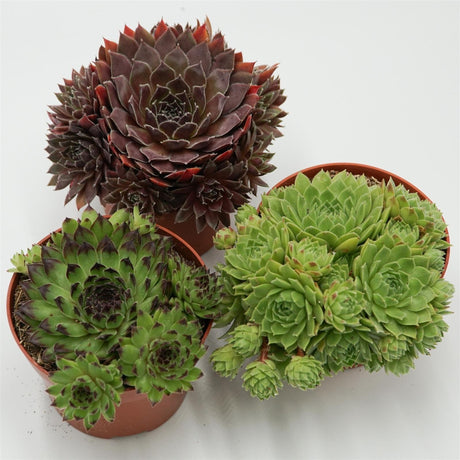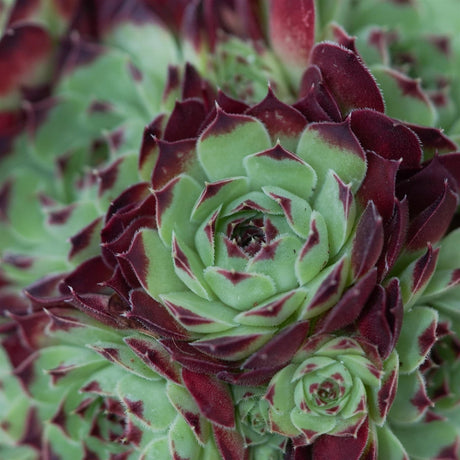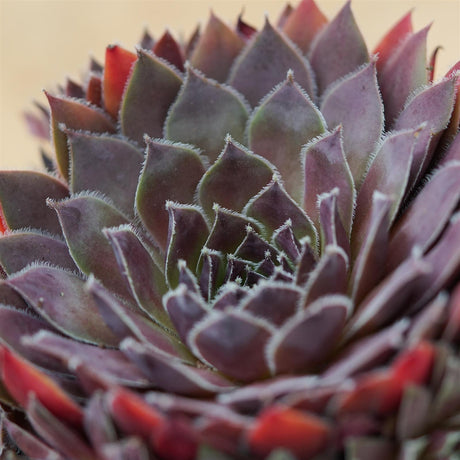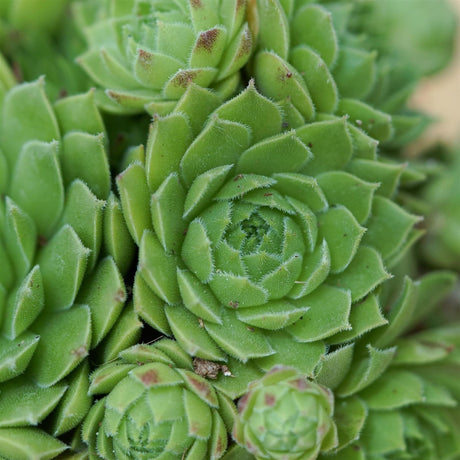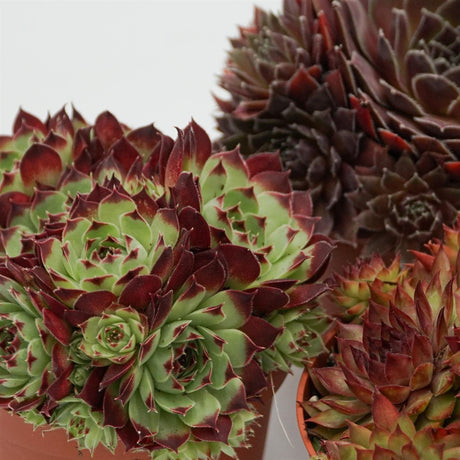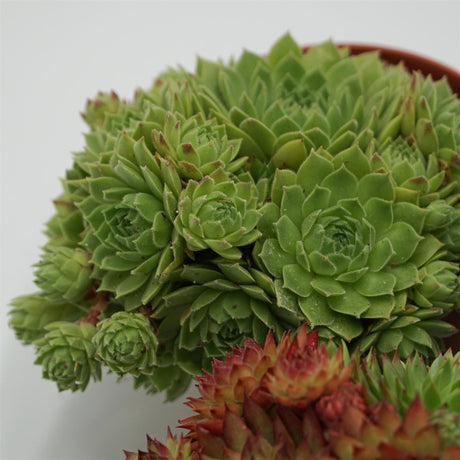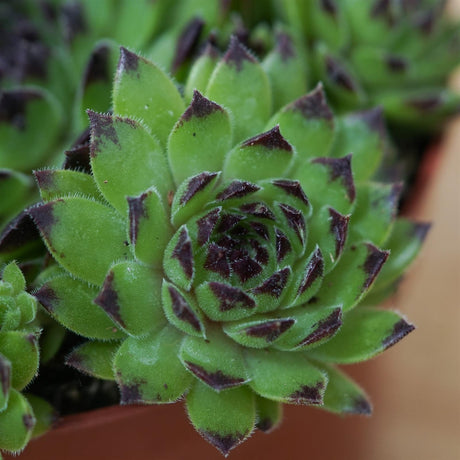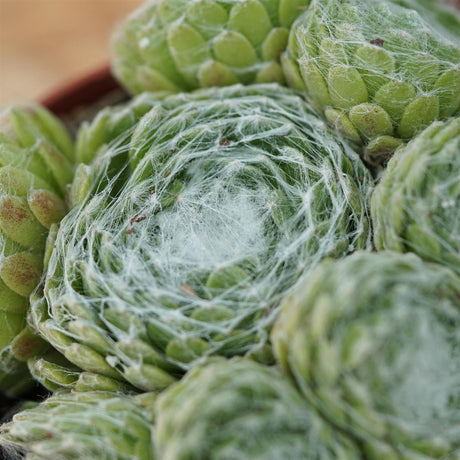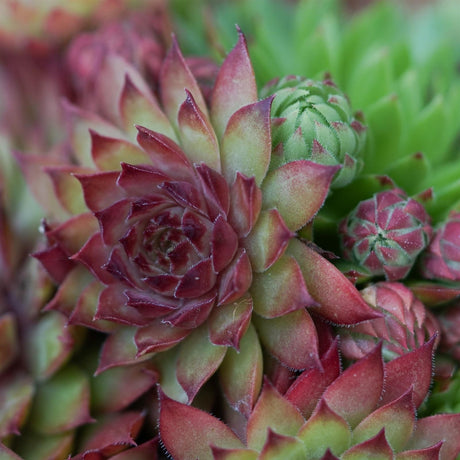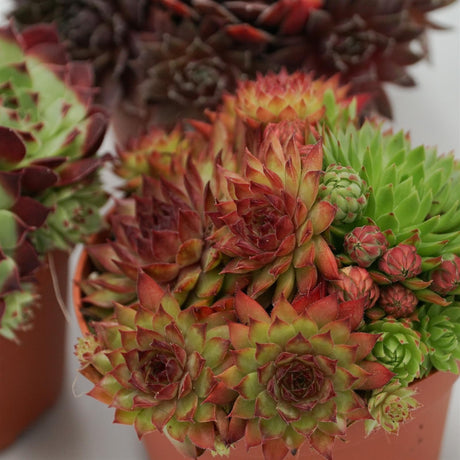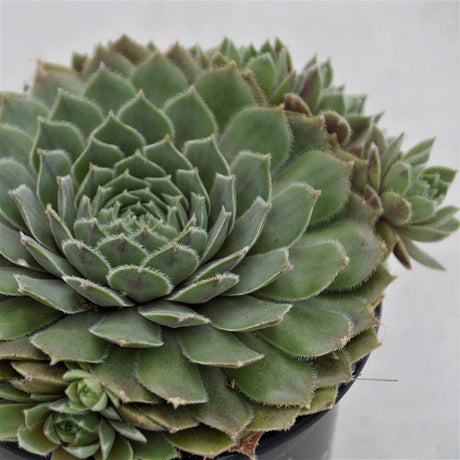Outdoor succulents
Hardy succulents are extremely robust in every respect. They can withstand both dry climates and frosty temperatures in your garden. Good drainage should be ensured in the substrate. Then these succulents will give you years of pleasure with minimal care.
They are suitable for:
- the garden
- Balcony planting
- Roof greening
- Grave plantings
- Dry stone walls
- Featured
- Best selling
- Alphabetically, A-Z
- Alphabetically, Z-A
- Price, low to high
- Price, high to low
- Date, old to new
- Date, new to old
FiltersFilter & Sort
- Regular price 11,80 €Unit price /Unavailable
- Regular price 6,20 €Unit price /Unavailable
Hardy succulents
Those who want to grow and care for succulents have a wide variety to choose from. There are many different species, and they not only look very different but also use different parts of their bodies for water storage. Caring for them properly isn't difficult in principle. Rather, succulents are very well-suited for people who sometimes forget to water them or don't regularly have time to care for their plants.
Succulents are versatile plants and above all, survival artists. Some succulent plants can even withstand frosty, cold winter days outdoors. These so-called hardy succulents are particularly useful if you like to leave your succulents in the garden all year round.
Those who want to grow and care for succulents have a wide variety to choose from. There are many different species, and they not only look very different but also use different parts of their bodies for water storage. Caring for them properly isn't difficult in principle. Rather, succulents are very well-suited for people who sometimes forget to water them or don't regularly have time to care for their plants.
Succulents are versatile plants and above all, survival artists. Some succulent plants can even withstand frosty, cold winter days outdoors. These so-called hardy succulents are particularly useful if you like to leave your succulents in the garden all year round.
What are hardy succulents?
Most succulents are accustomed to warmth, light, and sunshine and feel very comfortable in summer. However, there are also cold-resistant succulents that can withstand frost and winter temperatures. These are called hardy succulents. While a variety of succulents would not survive outdoors in winter because they originate from warm climates, hardy succulents are resilient. Many hardy species withstand temperatures down to -20° Celsius.
Which succulents are winter-hardy?
The 5 most beautiful hardy succulents
Sedum:
This succulent is also called stonecrop or goldilocks and comes in a wide variety of shapes and colors. There are over 300 species, some of which are even native to our region, such as Sedum acre.
Sempervivum:
This succulent, originating from Europe, is also known as houseleek and is completely winter-hardy. This means it can withstand temperatures down to -20° Celsius and impresses with its bizarre leaf shape.
Prickly pears:
Prickly pears are better known as fig cacti, and surprisingly, this genus also has some hardy species such as Opuntia fragilis and Opuntia polyacantha.
Agaves:
Relatively few agave species are hardy. They withstand temperatures down to -15° Celsius, but need protection from rain. Examples: Agave havardiana, Agave parryi, …
Yucca:
The Yucca is also called the giant palm lily and originally comes from Mexico. This genus also has hardy species: Yucca filamentosa and Yucca gloriosa.
Buy hardy succulents at Pasiora
Even though we specialize in succulents as houseplants – meaning non-hardy species – in our specialized nursery, we also have a small, seasonally changing selection of hardy succulents for outdoors.
Flowering succulents for outdoors
Like all succulents, hardy succulents usually bloom reliably once a year. Species of Sedum – the stonecrop – are particularly known for their profuse flowering.
Care must be taken with Sempervivum – the houseleeks. They only bloom when they reach a certain age. The flowering rosette dies after flowering, but beforehand it has often produced magnificent offspring – in the form of daughter rosettes. (Hardy) Agaves also only bloom once at the end of their lives.
Is my succulent for outdoors or indoors?
If you're not sure whether your succulent is suitable for outdoor use, try to determine the exact species. We'll show you how to do that here.
Generally speaking, if you're unsure, you should choose a wintering temperature between 5°C and 10°C - most succulents can handle these temperatures well.
From what point in time do I need to bring my non-hardy succulent indoors?
If the outside temperature consistently falls below 10°C at night, most succulents should be brought back inside the house or apartment. All heat-loving species should be placed on a windowsill, in the stairwell, in a conservatory, or in a greenhouse during winter. For proper care, their location should be bright and the temperature should ideally be between 5 and 15 degrees Celsius.
Of course, this does not apply to the care of native succulents such as houseleek, sedum, saxifrage or succulent species of stonecrop. They can withstand the outdoor temperatures prevailing here all year round and can therefore be planted and cared for outdoors.
How to care for hardy succulents
The most important thing when caring for hardy succulents is that they must not be watered during the winter months. From September onwards, watering should be stopped completely. The succulents then convert the remaining water into sugar. This reduces the water content in the plant cells. This is essential for the plants so that no water can freeze in the cells in winter. This protects the succulent from dying. Therefore, you must not water them and should also ensure that the hardy succulents are in a rain-protected location. A porch is well-suited for this. The succulent likes it dry. It also prefers a bright and warm location. While this is only conditionally possible in winter, a south-facing garden is best.
Can you plant succulents outside in the garden?
When planting hardy succulents, it is important to consider which substrate or soil type is best. Hardy succulents are often planted in rock gardens or on loose masonry.
Even non-hardy succulents can be planted in the garden after the last frost and up to night temperatures above 10°C.
Attention:Echeverias are not winter-hardy – even though this information is falsely spread.
Overwintering succulents outdoors in a pot.
But a normal plant pot or container also works perfectly in the garden. It's important that the soil is airy and loose. If you mix your own substrate, make sure you mix mineral substrate with conventional cactus soil. The mineral substrate ensures better drainage, allowing excess water to flow away. You can also add a drainage layer of gravel and expanded clay to the bottom of the pot yourself.
Caring for winter-hardy succulents in pots
To successfully overwinter and optimally care for these plants, some precautions should be taken. This is especially important if the substrate volume in the pot is relatively small. Then the root balls are often insufficiently protected. To properly care for these succulents, the pots should, if possible, be placed against a south-facing wall of the house and on wood or a Styrofoam board. Wrapping the pots with heat-insulating materials is also a good idea.
How to properly overwinter hardy succulents
In winter, hardy succulents fare best when planted in the ground. The soil there doesn't freeze as quickly as in a pot. A rock garden also has the advantage that the stones store some heat during the day and then release it slowly later.
Anyone who protects hardy succulents outdoors with fleece or other coverings must pay particular attention to removing them in time before the warm temperatures arrive. Otherwise, condensation and moisture build-up will occur, and in the worst case, even mold will form.
A covering is particularly useful for very large succulents such as agaves, which could be damaged if snow freezes in the rosettes.
Hardy succulents after winter
Once winter is over, you should gradually accustom the succulents to watering again. It's important not to overwater the succulent at first. After a while, you can resume the normal watering schedule, as the succulent will have become accustomed to the water supply again.
Accessories and care for garden plants
When the growing season begins, check if all succulents have survived the winter well or if something needs to be replanted. Or top up the soil if it has settled over time. Even hardy succulents benefit from fertilizer in spring. The rule of thumb applies whether indoors or outdoors: fertilize from Easter to October. Work long-term fertilizer or organic material into the succulent substrate to ensure they are well-nourished for a while.
Let customers speak for us
from 468 reviewsGesunde, mehrtriebige, formschöne Pflanze. Torf habe ich entfernt und in geeignetes Substrat umgetopft. Schneller Versand, gute Verpackung.

Erstmals bei Euch bestellt! Bestellvorgang und Lieferung war tiptop. Besonders schön fand ich den beiliegenden persönlichen Gruß (die Handschrift war etwas schwer zu entschlüsseln), sowie die Pflegeanleitung. Insgesamt erkennt man die Leidenschaft hinter dem Team. Ich kann Euch nur sehr gerne weiterempfehlen und komme bei meinem nächsten Kauf gern auf Euch zurück. Viele Grüße
Bis jetzt alles bestens! Das neue Pflänzchen scheint sich bei mir recht wohl zu fühlen. Ab und zu gibt es neben dem benötigten Wasser, noch ein freundliches Hallo von mir, zusätzlich zum täglichen "Guten Morgen Pflänzchen".

Sehr schöne gesunde Pflänzchen bekommen. Ich habe bereits 2 Mal bestellt :)

Prima für die Aufzucht, oder zum verschenken.

Sie wächst schnell und sieht einfach toll aus. Sie bekommt sogar Blüten, habe dieses Goldstück erst ein paar Wochen.

Die kleinen Härchen machen die Setosa richtig liebenswert. Sie sieht dadurch kuschelig aus.

Super verpackt und derInhaltistPerfekt!!!!
Jederzeit wieder.

Get 10% off your first order.
+ Exclusive tips, care guides and access to rare plants.

